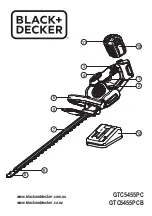
6
ENGLISH
(Original instructions)
u
Never attempt to force the blades to come to a standstill.
u
Do not put the tool down until the blades have come to a
complete standstill.
u
Regularly check the blades for damage and wear. Do not
use the tool when the blades are damaged.
u
Take care to avoid hard objects (e.g. metal wire, railings)
when trimming. Should you accidentally hit any such
object, immediately switch the tool off and check for any
damage.
u
Should the tool start to vibrate abnormally, immediately
switch it off and remove the battery then check for any
damage.
u
If the tool stalls, immediately switch it off. Remove the
battery before attempting to remove any obstructions.
u
After use, place the blade sheath supplied over the
blades. Store the tool, making sure that the blade is not
exposed.
u
Always ensure that all guards are fitted when using the
tool. Never attempt to use an incomplete tool or a tool with
unauthorised modifications
u
Never allow children to use the tool.
u
Be aware of falling debris when cutting the higher sides of
a hedge.
u
Always hold the tool with both hands and by the handles
provided.
Safety of others
u
This appliance is not intended for use by persons (includ-
ing children) with reduced physical, sensory or mental
capabilities, or lack of experience and knowledge, unless
they have been given supervision or instruction concern-
ing use of the appliance by a person responsible for their
safety.
u
Children should be supervised to ensure that they do not
play with the appliance.
Residual risks.
Additional residual risks may arise when using the tool which
may not be included in the enclosed safety warnings. These
risks can arise from misuse, prolonged use etc.
Even with the application of the relevant safety regulations
and the implementation of safety devices, certain residual
risks can not be avoided. These include:
u
Injuries caused by touching any rotating/moving parts.
u
Injuries caused when changing any parts, blades or ac-
cessories.
u
Injuries caused by prolonged use of a tool. When using
any tool for prolonged periods ensure you take regular
breaks.
u
Impairment of hearing.
u
Health hazards caused by breathing dust developed when
using your tool (example:- working with wood, especially
oak, beech and MDF.)
Vibration
The declared vibration emission values stated in the technical
data and the declaration of conformity have been measured
in accordance with a standard test method provided by
EN 60745 and may be used for comparing one tool with
another. The declared vibration emission value may also be
used in a preliminary assessment of exposure.
Warning!
The vibration emission value during actual use of
the power tool can differ from the declared value depending
on the ways in which the tool is used. The vibration level may
increase above the level stated.
When assessing vibration exposure to determine safety
measures required by 2002/44/EC to protect persons regularly
using power tools in employment, an estimation of vibration
exposure should consider, the actual conditions of use and the
way the tool is used, including taking account of all parts of the
operating cycle such as the times when the tool is switched off
and when it is running idle in addition to the trigger time.
Labels on tool
The following pictograms are shown on the tool along with the
date code:
:
Warning!
To reduce the risk of injury, the user
must read the instruction manual.
O
Wear safety glasses or goggles when operating
this tool.
N
Wear ear protection when operating this tool.
R
Do not expose the tool to rain or high humidity.
Remove battery pack before cleaning or
maintenance.
97
Directive 2000/14/EC guaranteed sound power.
Additional safety instructions for batteries and
chargers
Batteries
u
Never attempt to open for any reason.
u
Do not expose the battery to water.
u
Do not store in locations where the temperature may
exceed 40 °C.






























